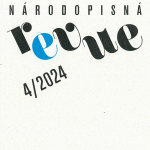
The paper is devoted to the analysis of folklore imagery in the literary theory of Ľudovít Štúr. Štúr defined Slavic poetry as the goal of the existence of the Slavic nation, by which they were to contribute to the harmonization of the world. The quality of this literature was determined by Štúr on the basis of Slavic folklore, and folklore imagery to be the guiding principle for Slavic creators. He paid special attention to the trope of natural-psychological parallelism, which he considered to be the realization of the definition of poetry, a synthesis of spiritual meaning and natural imagery. The paper analyzes Štúr's theory of folkloric imagery and notes the ideological dimensions of his interpretation. Štúr approached folklore very selectively, considering as a manifestation of the Slavic spirit only those contents and those tropes that he could reconcile with his own ideological premises.
The study characterises the interest of the Czechs in the Tatras up to the beginning of the 20th century, primarily in the pages of newspapers and magazines, but also as part of carnival celebrations. This interest is interpreted through the themes that were central to Czech travellers, who then reported on them in Czech periodicals. The most prevalent theme was shepherding, which as mentioned by almost all travellers who wrote about the Tatras. A less common theme was the motif of the Tatra mountain guide, which Czech travellers began to notice in detail from the last third of the 19th century onwards. The fact that Czech interest in the Tatras continued into the late 19th and early 20th centuries, especially on the Galician (Polish) side, is evidenced by the inclusion of the theme of the mountain centre of Zakopane and the Polish Tatras as the main title of the Sokol “Šibřinky” in 1902.
Occasional poetry was an inseparable part of the celebration of the national holiday of 28 October in interwar Czechoslovakia. In the context of a holiday whose celebrations had a deliberately nation-building character, it represented not only a form of celebration, but also one of the sources for interpreting the narrative of the holiday, which was also supposed to strengthen the relationship to the independent Czechoslovak state. The study focuses on research into holiday poetry in the children’s supplements and columns of the most important Czech newspapers of so called the First Czechoslovak Republic. The analysis of themes and motivic structure as well as stylistic and language devices will answer the question of what role holiday poetry for children played and what it communicated to them with the intention of shaping their attitude towards their homeland. Methodologically, the study is based on the foundations of media and memory studies in an interdisciplinary connection with literary science approaches.
Southwestern Moravia was ethnically diverse until the mid-20th century, and many of its inhabitants were characterised by a fluid ethnicity. The example of the border village of Panenská (Frauendorf, Flandorf) is used to study the process of ethnic self-identification of the inhabitants in an ethnically mixed village at the turn of the 19th and 20th centuries. The aim is not only to show how the ethnic self-identification of the village's inhabitants developed, but also to identify the main actors who influenced the process of self-identification and the strategies they used. The study focuses on the analysis of the ethnic situation based on the analysis and interpretation of archival materials (censuses, registers, chronicles, minutes of village council meetings, newspaper articles). Economic and political developments in the municipality were also taken into account.
The aim of the study is to analyse different historical interpretations of stećci (that is medieval tombstone from Bosnia and Herzegovina and surrounding regions) and to highlight their use in the construction of national narratives and territorial claims. The study compares national interpretations that present stećci as symbols of specific ethnic groups (Bosniaks, Serbs, and Croats) with modern research emphasizing their multi-confessional character. Particular attention is paid to the so-called "Bogomil myth", which associates the stećci with the heretical Bogomil sect, and its role in ideological discourses from the 19th century to the present day. The research shows that the stećci represent a significant cultural heritage that cannot be reduced to a single religious or ethnic narrative.
Shifting Tradition
New Tradition “Closing of the Vineyards“ in Moravské Bránice (Eva Večerková)
Jubilees and Obituaries
Congratulations to Kornélia Jakubíková on Her Eightieth Birthday (Alexandra Navrátilová)
František Hýbl Has Passed Away (Miroslav Válka)
In Memoriam Karel Severin (Jana Pospíšilová – Miroslav Válka)
Exhibitions
Crafts and Craftsmen in the Kralovice Area (Marta Ulrychová)
Exhibition of Bobbin Lace at Švihov Castle (Marta Ulrychová)
News
Intangible Cultural Heritage and Climate Change (Přemysl Mácha)
Reviews
P. Mazný – T. Bernhardt – L. Silovský – K. Fantová: Plzeňské tajnosti [Secrets of Pilsen] (Marta Ulrychová)
L. Běťák (ed.): Zpívalo se v Osvětimanech [Singing in Osvětimany] (Věra Frolcová)
CD Ľudová hudba Javorníček a kamaráti: Po kysucky. Tradičná hudba a piesne Kysúc [The Javorníček Folk Music
Band and Friends: Playing in the Kysuce Way: Traditional Music and Songs of the Kysuce Region] (Anna Pohořálková)
Sborník Muzea Českého lesa v Tachově 38 [Almanac of the Museum of the Bohemian Forest in Tachov, Vol. 38] (Marta Ulrychová)
Contents in English
10469
10468
10467
10466
10465